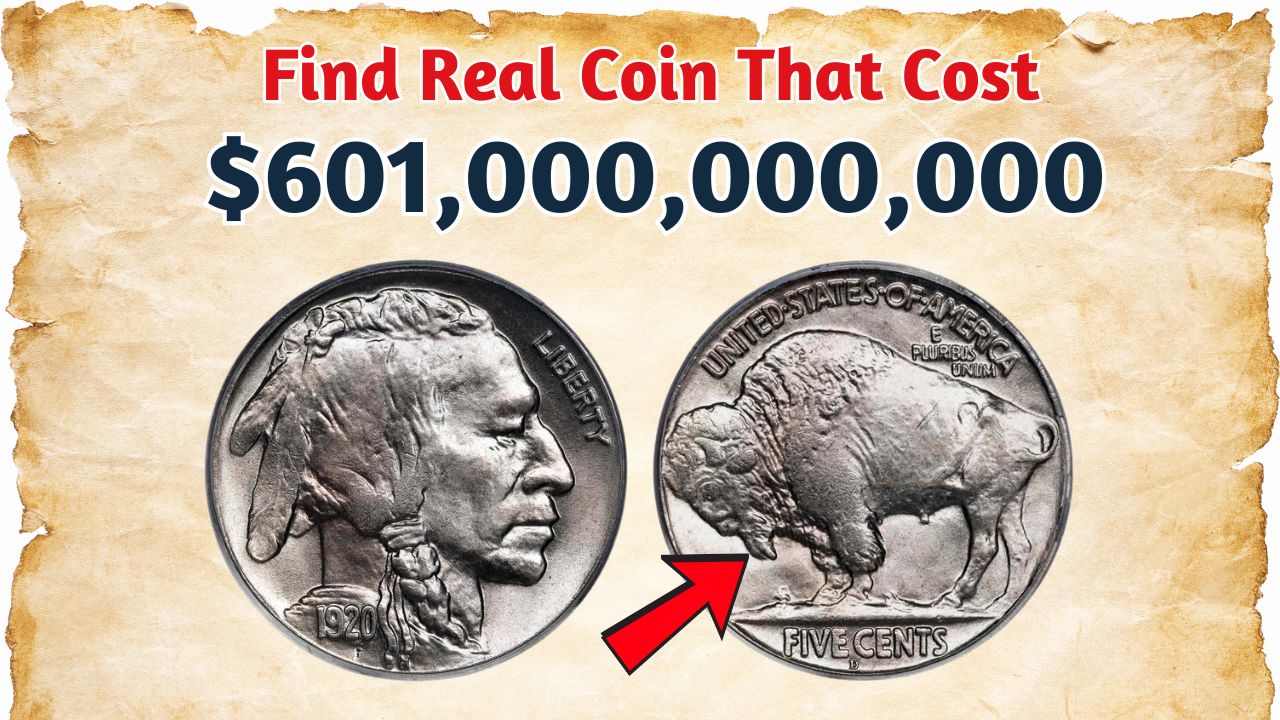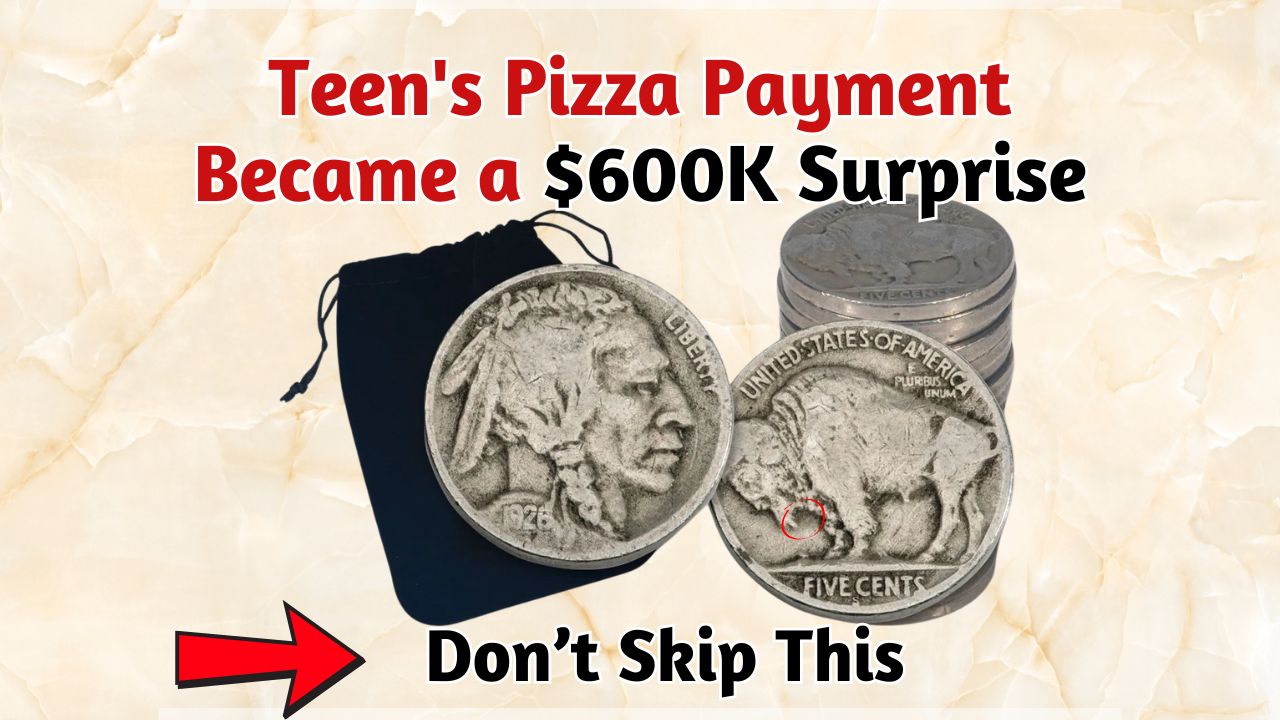In a bewildering revelation that has turned heads among coin collectors and curious citizens alike, a version of the storied Buffalo Nickel — one of the most culturally rich and visually distinct coins in American numismatics — has been appraised at an astonishing $601K million. Yes, you read that right.
Symbol Carved in Copper Nickel
The Buffalo Nickel, formally named the Indian Head Nickel, made its first appearance in 1913 and was struck until 1938. Crafted by renowned sculptor James Earle Fraser, the coin encapsulates a fiercely American identity. On one side, a Native American profile exudes stoic pride, while the reverse presents a hulking American bison — a creature synonymous with the nation’s untamed wilderness.
Introduced during an era when the U.S. Mint sought to create coinage reflective of American heritage rather than neoclassical Europe, the Buffalo Nickel quickly became a canvas of national storytelling.
Over time, these coins have become prized tokens in the world of numismatics. While most specimens fetch modest figures, select issues — particularly those laced with historical anomalies or pristine condition — have been auctioned for mind-bending sums.
Buffalo Nickel Worth Fortune
The extraordinary valuation of $601K million is not plucked from the wind. A confluence of factors contributes to this surreal figure, many of which rest in the coin’s rarity and unblemished integrity.
Factors Contributing to the Coin’s Massive Worth
| Feature | Explanation |
|---|---|
| Mint Condition (MS Grade) | Coins graded “Mint State” or above by professional services can attract enormous premiums due to their unspoiled preservation. |
| Minting Errors | Flaws like the “three-legged buffalo,” off-center strikes, or double dies make certain specimens unicorns in the collector world. |
| Historic and Cultural Gravitas | As relics of a bygone America, these coins resonate deeply with collectors who value narrative as much as numismatic worth. |
| Low Mintage or Key Dates | Particular production years and mint marks — especially from the Denver or San Francisco mints — are exceedingly rare. |
It’s not merely a coin; it’s a time capsule with texture, tone, and tales — a blend of metallurgical craft and serendipity.
Still in Circulation
What has truly galvanized public intrigue is the speculation that a few of these immensely valuable coins might still be quietly circulating in the public domain — tucked away in piggy banks, vintage coin jars, or the shadowy corners of old purses.
During its 25-year run, millions of Buffalo Nickels were produced. It’s not far-fetched to believe that a few unicorns slipped through the sieve of history, unnoticed and unappreciated. Imagine discovering a seven-figure fortune wedged between couch cushions — a windfall cloaked in nickel alloy.
How to Identity the Real One?
For those now tempted to go spelunking through their coin stashes, here are some specific indicators collectors and experts emphasize when hunting for valuable Buffalo Nickels:
Identifying a Valuable Buffalo Nickel
| Key Indicator | Description |
|---|---|
| Date & Mint Mark | Watch for early issues like 1913 Type 1 and coins minted in San Francisco (S) or Denver (D). |
| Visual Oddities | Missing legs on the buffalo, extra outlines, off-center stamping, or unusually thick letters may signal an error coin. |
| Overall Condition | Crisp lines, bold imagery, and lack of wear — even minor details matter. |
| Surface Texture | Coins with unusual luster or coloration may indicate a unique batch or chemical interaction. |
However, an authentic valuation often requires expert verification. Reputable grading services like PCGS or NGC can offer certification and market validation.
Rise of Tangible Treasures
This sudden media whirlwind around a once-ordinary coin isn’t occurring in isolation. Across the U.S., interest in rare coins and tangible assets has quietly escalated, partly fueled by economic instability and digital fatigue. As people look for safer, story-rich investments, numismatics has surged as a haven of both passion and profit.
There’s a certain poetic justice in finding immense value in something so seemingly mundane. The idea that life-changing wealth could be resting unnoticed in a mason jar or sock drawer is a modern fairytale grounded in gritty possibility.
Revival of the Collector’s Spirit
The idea that rare coins might be hiding in plain sight has rekindled a spark across age groups. Whether driven by nostalgia, economic curiosity, or the thrill of the hunt, Americans are increasingly rediscovering the coin collections of their grandparents — and sometimes, striking literal gold.
The Buffalo Nickel’s dramatic appraisal has served as a catalyst for this resurgence. Stories of everyday individuals stumbling upon treasure in ordinary places have become part of a larger cultural narrative — one that fuses history with the unexpected.
Closing Thoughts
A Buffalo Nickel commanding $601K million may seem like fiction painted in metallic tones, but the world of rare coins defies predictability. It’s a domain where forgotten currency transforms into legendary artifacts, where the past speaks through metal, and where value is forged not just in rarity, but in story.
If nothing else, let this be a quiet call to action. Next time you feel the jingle of loose change, pause for a moment. There could be a slice of history — and perhaps a small fortune — waiting for rediscovery.
FAQs
What is the Buffalo Nickel and why is it so valuable?
The Buffalo Nickel, officially called the Indian Head Nickel, is a U.S. coin minted between 1913 and 1938. Its value skyrockets due to rare minting errors, historical significance, and pristine condition, with some versions now valued at $601K million.
Are valuable Buffalo Nickels still in circulation?
Yes, experts believe a few rare Buffalo Nickels could still be found in everyday circulation, especially in old coin jars, piggy banks, or inherited collections.
What should I look for to identify a rare Buffalo Nickel?
Look for specific dates like 1913, mint marks from San Francisco or Denver, and unique minting errors such as the ‘three-legged buffalo’ variety. Also, coins in near-perfect condition are highly sought after.
How do I get a Buffalo Nickel professionally evaluated?
You can send your coin to certified grading services like PCGS or NGC for expert analysis, authentication, and market value appraisal.
Why are rare coins gaining popularity again?
With economic uncertainties, many investors are turning to tangible assets like rare coins. Their historical importance, limited availability, and potential financial value have made them highly desirable.













I have a 1936 nickle
I HAVE A 1936 BUFFALO NICKEL A IT IS IN VERY GOOD CANDITION.
HOU MUCH IS ITS VALUE ?
I ALSO HAVE THE MOST EXPENSIVES WASHINGTON QURTERS FOR SALE
1967, 1966,1965 NO MINTMARK GOOD CONDIT.
ALSO A 1975 DIME NO MINTMARK REALLY VALUABLE DIME
I need to take my coins to shop I leave in Lancaster
Need a book please
I have a 1964 half dollar coin which I would like to sell.
I have a 1926 Buffalo nickel, is it worth,anything
I have 2 bicential quarters with the drummer and the stars and I also have a Buffalo nickel and it’s a 1934 in fair condition
I have all these coins were do I go from here
Anyone interested in the buffalo nickels I have 3
What years are your Buffalo nickels
What year and mint mark should I know to look for ???
Homeless inst fun without transportation is a very frustrating barely alive y’all tayed my grandpa, y’d my electrical I o the founding father ain’t I that liquid. Sooner or later this so called globe will get the hint across this colony several ways or another thanks a lot for insuring misery jokes on me u
I have some bicentennial quarters and I’d like to know exactly what I’m looking for that makes them rare, Iv got one that is faded some but it’s a quarter that was black, colored by the place that minted them, I have a 1962 quarter that has the mint mark on the back right above the ‘quarter Dollar ‘ sign.. etc. can you help find out what they are worth, so I can sell them. Ty.
I have the 1929 Buffalo Nickel
I have one butfalo coin
I Have a 5 Centavos Buffalo Nickel Coin and I Want to Sell it.
I have a nickel 1923 with Indian in front and Buffalo not in mint condition what is it woth
Hi My name is MarilynLowery and I want to sell my 3 leg nickel to someone who would I speak to? My email address is [email protected]. My home number is 2169723242.
The best thing to do is to send it off to NCG or PCGS to have it graded and checked for authentication. This way you get what it’s worth and no get ripped off. I collect and buy coins myself and always use these companies because they are the best. Condition of the coin is what matters the most.
Hi My name is MarilynLowery and I want to sell my 3 leg nickel to someone who would I speak to? My email address is [email protected]. My home number is 2169723232.
It nice that someone posts all of the coins that is worth money. Thank everyone for reading my comment
I have coins 1900 I have nickel Indian Head
Good..Lakeside
Hello , I have a buffalo nickel 1930 with the long chin ,I want to sell it .
E-mail me : [email protected]
100
I have an old coins of Nickel buffalo
I got a 1943 penny and bicentennial quarters 4 I want to sell
Blessings to you all. I have six lincoln wheat penny’s three buffalo nickels and many more historic coins that I need to sell.please contact at [email protected] thank you for communicating This is very serious I need to sell them all.